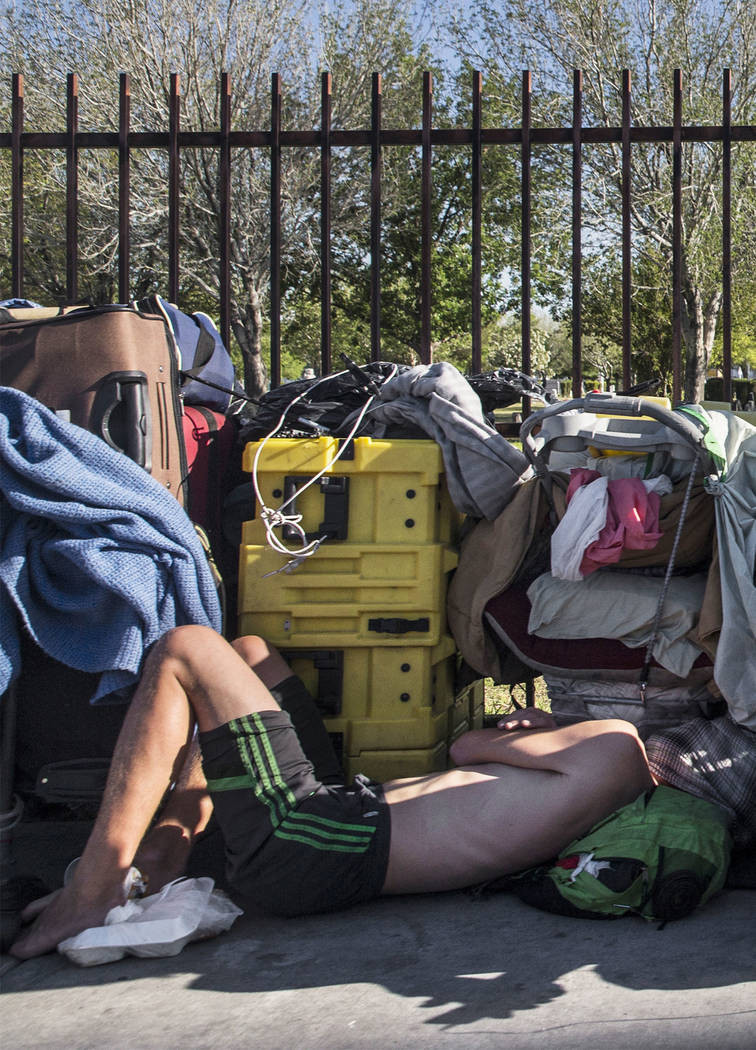Downtown Las Vegas forum explores ways to address homelessness


A young girl Kenny Wilson saw as he walked across San Antonio’s Haven for Hope campus stuck in his mind — she looked just like his 11-year-old granddaughter.
“I went in a stairwell and wept,” Wilson recalled as he spoke before a group gathered for a forum on homelessness in downtown Las Vegas Thursday night.
Wilson is the president and CEO of the 22-acre Haven for Hope, a campus where San Antonio’s homeless population can seek a range of services. The city of Las Vegas’ new courtyard project is based in part on the San Antonio model.
Mental health issues have been pervasive in the people who have sought services and stayed at Haven for Hope since it opened in 2010, Wilson said.
“It’s all about mental health, in my opinion,” hesaid.
Addressing mental health issues that contribute to “chronic and systemic homelessness” is key, said Deacon Tom Roberts, president and CEO of Catholic Charities of Southern Nevada.
“That’s what we need to solve in the courtyard if we want to make real and meaningful change,” Roberts said.
Corridor of Hope
Las Vegas launched the courtyard last year at Foremaster Lane and Las Vegas Boulevard North. The area is known as the “Corridor of Hope,” where shelters and other homeless service providers are clustered. Las Vegas’ courtyard now essentially consists of a parking lot and older buildings where the city has been offering many of the services planned for the full-scale courtyard during the day.
The city’s courtyard is aimed at serving the homeless population in the downtown Las Vegas area.
“We’re not going to solve this with 5 acres in downtown Las Vegas,” Roberts said, adding the courtyard should be a model that can be replicated throughout the valley.
The Downtown Vegas Alliance put on Thursday’s Successes and Insights on Homelessness forum at Las Vegas City Hall. Alliance Executive Director Michael Vannozzi moderated the panel discussion and ended the evening pushing for more local collaboration on homelessness issues.
“It’s not an issue one city can tackle alone,” Vannozzi said.
Las Vegas Mayor Carolyn Goodman said the talk about the valley’s homeless issues has persisted for years but is “useless” without measurable action.
“So much talk, so many meetings, but never change, never impact, never results,” Goodman said.
’There’s no one way”
San Antonio’s Haven for Hope has about 1,700 people staying on the campus, split between dorms and an open-air courtyard.
Haven for Hope’s dorms have a higher barrier for entry than the courtyard; no sex offenders are allowed to stay there. The courtyard has a lower barrier for entry: people can be admitted if they’re inebriated.
Of the 148 agencies that provide services on the campus, 36 of them have offices there.
“What I’m not going to do is represent to you that Haven for Hope is what you need to do,” Wilson said. “It is a way. It is not the way. … There’s no one way.”
Las Vegas’ courtyard serves as a “low-barrier, triage” entry point for homeless people, said Kathi Thomas-Gibson, Las Vegas’ community resource manager.
A roughly $15 million courtyard will be built out over a few years, eventually operating 24/7, with a sleeping area. Outreach teams will make contact with homeless people and encourage them to seek services at the courtyard.
Unlike San Antonio’s project, which touched off with tens of millions of private dollars, Las Vegas doesn’t have significant private investment in its project.
The city has funding lined up for the campus startup and build-out, but needs to find another funding source for operations in future years.
City officials are seeking a “stronger and more immediate partnership” from the private sector, Goodman said.
Wilson urged Las Vegans not to view homelessness just as “we need to get people off the streets.”
“These are people that need your help,” Wilson said.
Contact Jamie Munks at jmunks@reviewjournal.com or 702-383-0340. Follow @Journo_Jamie_ on Twitter.













